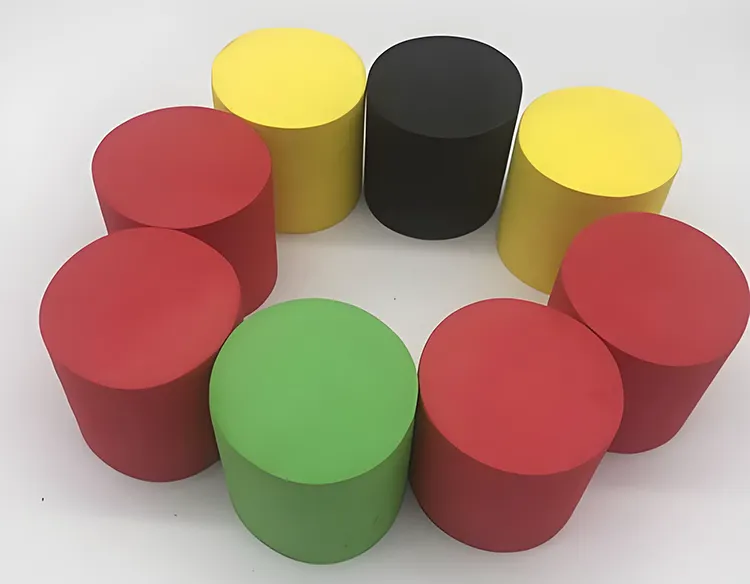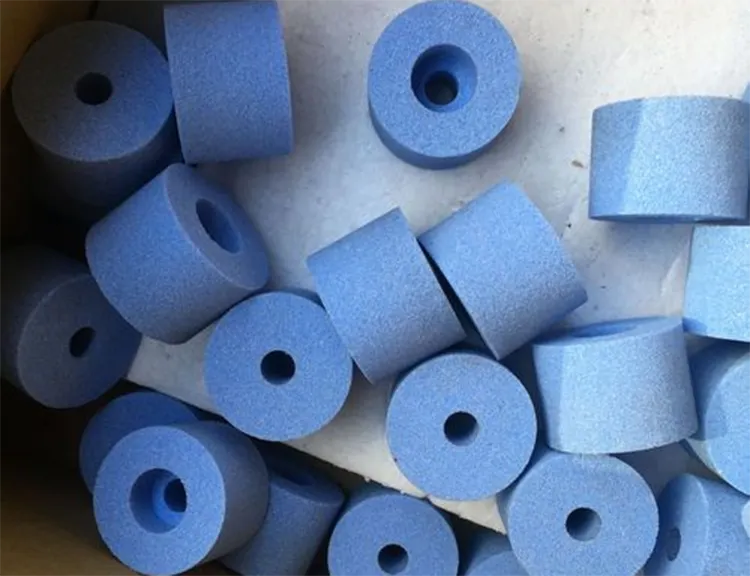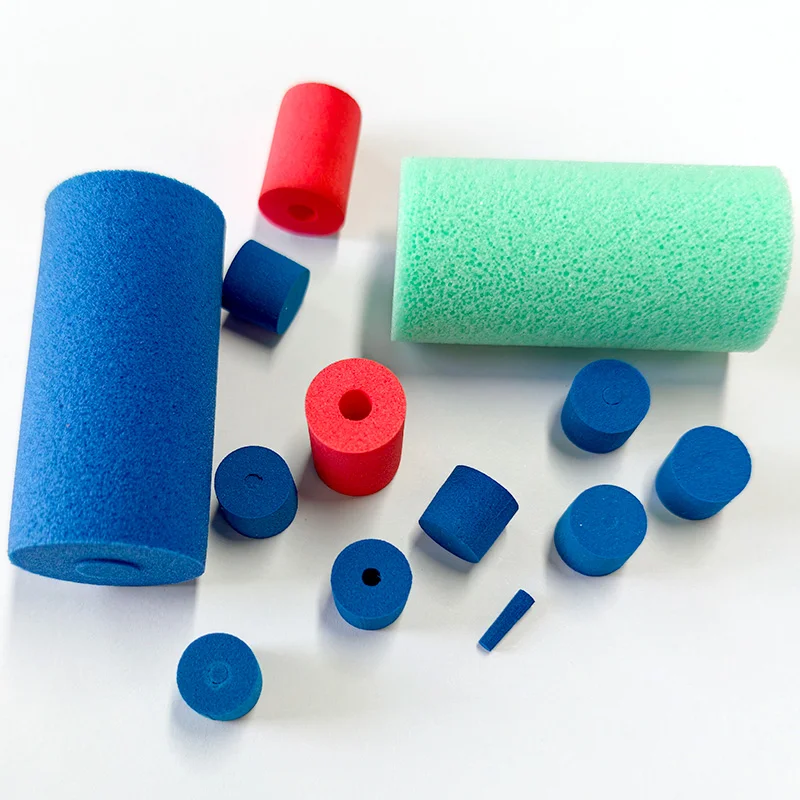Selecting the right polyurethane foam cylinder is not simply a matter of choosing a size or density. True engineering selection requires an understanding of load, stroke, frequency, geometry, environmental conditions, tolerances, and fatigue behavior. A polyurethane cylinder that performs perfectly in an automotive interior may fail prematurely in a robotic end-stop. A soft foam that works well for HVAC vibration control may bottom out in heavy industrial applications.
This guide walks engineers through the complete decision-making process, helping you select the correct polyurethane foam cylinder for reliability, longevity, and consistent damping performance—whether you’re working on robotics, machinery, HVAC systems, appliances, or construction projects.
If you need a refresher on how PU foam cylinders are structured, read:
👉 What Is a Polyurethane Foam Cylinder?
And for real-world applications:
👉 Top Applications of Polyurethane Foam Cylinders
1. Introduction
In many engineering projects, premature failure of a foam damping component is not due to poor manufacturing—it is often due to incorrect selection. Choosing the right polyurethane foam cylinder ensures:
- Stable and predictable damping
- Long fatigue life
- Reduced vibration and noise
- Protection of adjacent components
- Improved mechanical efficiency
- Lower maintenance cost
A well-selected foam cylinder improves both performance and product lifespan. The wrong choice—too soft, too hard, or wrong geometry—can lead to:
- Bottoming out
- Excessive rebound
- Permanent deformation
- Structural vibration issues
- Noise problems
- Unexpected equipment wear
This guide provides the complete engineering framework to avoid such issues.
2. Understanding How PU Foam Cylinders Behave Under Load
Polyurethane foam does not compress in a linear way. Its unique progressive compression curve makes it ideal for damping applications.
2.1 Compression Curve Basics
A typical PU foam compression curve has three zones:
- Initial Soft Compression
Very low force required; ideal for gentle engagement and noise reduction. - Mid-Range Energy Absorption
Force increases as cells collapse; most damping occurs here. - High-Stiffness “Bottoming Zone”
Prevents hard impact and protects critical components.
A properly selected foam cylinder should operate mostly in the middle zone, not at the extremes.
2.2 Elastic Recovery & Fatigue Behavior
Polyurethane foam cylinders recover quickly after compression due to the material’s elastic microstructure.
Fatigue behavior depends on:
- Density
- Hardness
- Operating stroke
- Frequency of cycles
- Environmental conditions
High-frequency applications (motors, robotics) require foam that rebounds rapidly and resists compression set.
2.3 Load-Deflection Relationship
Engineers must define:
- Maximum load → Peak force
- Average load → Continuous force
- Acceptable compression → Usually 30–60%
- Maximum safe deflection → Avoid pushing cylinder into the bottoming zone
Without this load-deflection analysis, cylinder failure is likely.
3. Key Parameters Engineers Must Determine Before Choosing a Cylinder
Before selecting a cylinder, gather the following critical information.
3.1 Load (Static & Dynamic)
Static Load
Force applied evenly over time—important for spacers or mounts.
Dynamic Load
Force varying with movement—critical for damping or impact applications.
Impact Load
Sudden, high-force events such as robotic end-stops.
Different densities respond differently to each load type.
3.2 Stroke / Target Compression
Typical compression guidelines:
- Light damping: 15–30% compression
- General vibration control: 30–50%
- Heavy impact zones: 50–70%
Exceeding 70% compression can cause:
- Premature fatigue
- Permanent deformation
- Bottoming out
3.3 Frequency of Operation
High-frequency cycling requires:
- Higher density
- Faster recovery foam
- Stable dimensional tolerance
Low-frequency applications allow softer, lighter grades.
3.4 Equipment Tolerances
Evaluate:
- Clearance fit
- Shaft or housing diameter (for hollow cylinders)
- Allowable preload
- Dimensional stack-up
Tolerances of ±0.5–1.5 mm are typical; tighter tolerances require laser cutting.
4. Choosing the Right Density (200–600 kg/m³)
Polyurethane foam density directly affects stiffness, damping behavior, and fatigue life.
4.1 Density Impact on Performance
- 200–300 kg/m³: Soft → Best for comfort, NVH, low load
- 300–450 kg/m³: Medium → Best for multipurpose damping
- 450–600 kg/m³: Hard → Best for heavy industrial loads
Higher density means:
- Higher load capacity
- Better durability
- Increased weight
- Slightly higher cost
4.2 Density vs Weight, Cost, and Stability
- Low density → Cheaper but less durable
- Medium density → Most balanced option (HVAC, automotive, electronics)
- High density → More expensive but long-lasting
Industrial automation almost always requires 350+ kg/m³ foam for reliable cycling.
For detailed material comparison (PU vs EVA/NBR/silicone), see:
👉 Polyurethane vs Other Foam Materials
5. Understanding Hardness (Shore A Equivalent)
Though foam doesn’t use Shore A directly, engineers often approximate hardness levels using foam density and ILD/IFD measurements.
5.1 Hardness vs Damping Feel
Approximate equivalence:
- 20–30 Shore A: Very soft → Sound damping, gentle engagement
- 40–50 Shore A: Medium → General-purpose damping
- 60–70 Shore A: Firm → Heavy machinery, high loads
5.2 Hardness vs Fatigue Life
Softer foams fatigue more quickly in:
- High-cycle motors
- HVAC fans
- Robotics
Harder foams resist repeated compression and should be used for:
- Impact zones
- Reciprocating equipment
- Linear actuators
5.3 Color Coding for Hardness
Many OEMs use color coding to differentiate densities or hardness levels—useful for assembly and maintenance. Kinsoe can match or customize these codes for your project.
6. Selecting Geometry: Solid vs Hollow Cylinders
Geometry dramatically changes damping profile.
6.1 Solid Cylinder
- Maximum structural integrity
- High load capacity
- Best for direct compression and impact loads
- Common in industrial robots and machinery

6.2 Hollow / Concentric Cylinder
- More progressive damping
- Less rebound
- Mountable over bolts or shafts
- Lighter and more efficient
- Ideal for HVAC, automotive interiors, electronics, appliances

6.3 Mixed-Density Configurations
Advanced OEM designs may use:
- Soft outer layer + firm inner core
- Dual-density foam cylinders
- Hybrid designs to tune compression behavior
6.4 How Shape Affects Compression
Hollow cylinders:
- Compress more uniformly
- Create two-stage damping curves
- Reduce peak impact force
Solid cylinders:
- Have higher stiffness
- Are better for short, high-energy impact zones
7. Temperature Conditions
7.1 Operating Temperature Range
Typical polyurethane cylinder temperature range:
- −40°C to +80°C
Beyond this range:
- PU softens at high temperature
- PU hardens at very low temperature
Choose silicone foam if temperatures consistently exceed 100–120°C.
For high-temp comparison:
👉 Polyurethane vs Other Foam Materials
8. Humidity, Water & Chemical Exposure
8.1 Moisture Absorption
- Open-cell PU: absorbs moisture; best for indoor use
- Closed-cell PU: moisture-resistant; suitable for HVAC or humid environments
8.2 Oils & Solvents
PU performs well in mild oil/chemical environments, but for continuous oil exposure, choose NBR foam instead.
Examples:
- Oil-soaked factory floors
- Oil cooling systems
- Mechanical lubrication zones
9. UV, Outdoor Weathering & Service Life
PU foam is typically protected from UV; unprotected outdoor exposure can cause:
- Hardening
- Cracking
- Reduced elasticity
Use additives, coatings, or protective housings for outdoor applications.
Expected lifespan varies from 2 to 10 years, depending on density, load, environment, and cycling frequency.
10. Choosing OD, ID, and Length (Dimensional Engineering)
10.1 Outer Diameter (OD)
OD selection controls:
- Load distribution
- Structural stability
- Compression speed
A larger OD distributes force over a wider area.
10.2 Inner Diameter (ID) — For Hollow Cylinders
ID must accommodate:
- Shaft tolerance
- Thermal expansion
- Preload requirements
Press-fit vs slip-fit considerations:
- Press-fit → eliminates rattling
- Slip-fit → easier assembly
10.3 Length
Longer cylinders:
- Deform more gradually
- Reduce peak impact forces
- Spread load over a larger compression zone
Short cylinders:
- Stiffer overall
- Better for tight installations
11. Manufacturing Tolerances & Precision Cutting
11.1 Typical Tolerance Ranges
- ±0.5 mm for small parts
- ±1.0–1.5 mm for larger diameters
11.2 Benefits of Laser Cutting
Compared with conventional cutting:
- More precise OD/ID
- Clean edges
- Better concentricity
- Ideal for high-performance OEM projects
Kinsoe specializes in laser-cut PU foam cylinders for demanding tolerance applications.
12. Common Design Mistakes Engineers Must Avoid
12.1 Choosing Foam That Is Too Soft
Results in:
- Bottoming out
- Permanent deformation
- Noise issues
12.2 Choosing Foam That Is Too Hard
Leads to:
- Insufficient damping
- Sharp rebound
- Increased vibration
12.3 Ignoring Environment
Foam exposed to:
- Heat
- UV
- Oils
12.4 Poor Dimensional Selection
- Over-tight ID causes installation difficulty
- Loose fit causes rattling
- Incorrect OD causes offset loading
13. Example Calculations & Case Studies
13.1 Industrial Robotic End-Stop
- Load: 50 N
- Compression target: 40%
- Density: 400–500 kg/m³
- Geometry: Solid cylinder
13.2 Automotive Interior Soft Stop
- Low load
- Noise-sensitive
- Density: 200–300 kg/m³
- Geometry: Soft solid or hollow cylinder
13.3 HVAC Fan Motor Mount
- High cycling frequency
- Medium load
- Density: 300–400 kg/m³
- Geometry: Hollow cylinder for progressive damping
See the full application guide for more examples:
👉 https://www.kinsoe.com/polyurethane-foam-cylinder-applications/
14. What Engineers Should Prepare Before Contacting a Supplier
14.1 Required Technical Data
- OD / ID / length
- Expected load
- Compression target
- Operating environment
- Frequency of cycling
- Preferred density (if known)
14.2 Optional Requirements
- Color coding
- Adhesive layer
- Fire rating
- Specific tolerance class
15. Kinsoe’s Customization Capabilities
Kinsoe provides:
- Precision laser cutting
- Custom density and hardness tuning
- Dual-density configurations
- OEM manufacturing
- Small-batch prototyping
- Full-scale mass production
- Engineering support based on drawings or samples
16. Additional Resources for Better Material Selection
- Structure & fundamentals:
https://www.kinsoe.com/what-is-polyurethane-foam-cylinder/ - Applications by industry:
https://www.kinsoe.com/polyurethane-foam-cylinder-applications/ - Material comparison:
https://www.kinsoe.com/polyurethane-vs-other-foam-cylinders/
17. Summary
To select the right polyurethane foam cylinder:
- Define load and stroke
- Determine compression target
- Identify cycling frequency
- Choose density and hardness
- Select solid or hollow geometry
- Consider temperature and environment
- Evaluate dimensional tolerances
- Validate with prototypes
Proper selection increases reliability and long-term performance.
If you need help choosing the right polyurethane foam cylinder, or if you require a custom-engineered solution, visit our product page:
👉 Polyurethane Foam Cylinder — Custom Manufacturing
You may also send your drawings or technical requirements for a detailed engineering consultation.


